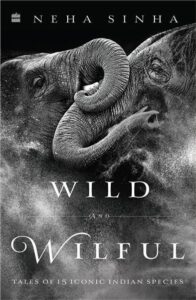To quote Mr. Bruce Springsteen, “Born in the U.S.A / I was born in the U.S.A.” As such, and still residing there, I have too often found it too easy to become somewhat isolated from the rest of the world. As a country, the United States is both geographically large and culturally… well, loud might be the most effective word for it. So when one is inside the U.S., it’s not uncommon to develop a feeling that the rest of the world revolves around it.
It doesn’t, of course, and I try to do what I can to keep such perspectives at bay. Unfortunately, the laws that govern media don’t make that an easy job. Without going to a significant amount of effort, those of us in the U.S. don’t generally see television programs, hear radio broadcasts, or read books produced in other countries. And as you might expect, it’s the challenge of obtaining books from other countries that most irritates me. Indeed, if it wasn’t for having become familiar with and quite fond of Blackwell’s a few years ago, I’d often find myself bereft of access to many of the fine natural history books published in the U.K. that never see publication as U.S. editions. But as I discovered recently, the U.K. isn’t the only nation to which I should be turning in search of new works of natural history published in English – I need to be looking even farther to the east (or west, depending upon which way I spin the globe on my desk) to India.
For those who, like me until very recently, might not have been aware of the remarkable tradition and culture of natural history in India, I highly encourage spending a bit of time looking into it. Not only is India the home of some of the world’s finest naturalists – both from the past as well as presently living and very much active – it’s culture of natural history study is superbly rigorous as well as participatory to a level I find very refreshing indeed.
 You might justly ask what finally opened my blinkered eyes to the fact that a nation with a population nearly four times larger than that of the one in which I live, and a history that exceeds that of my own by more than an order of magnitude possessed such an active level of practice in a field about which I care very deeply. It was Neha Sinha’s remarkable book Wild and Wilful; Tales of 15 Iconic Indian Species.
You might justly ask what finally opened my blinkered eyes to the fact that a nation with a population nearly four times larger than that of the one in which I live, and a history that exceeds that of my own by more than an order of magnitude possessed such an active level of practice in a field about which I care very deeply. It was Neha Sinha’s remarkable book Wild and Wilful; Tales of 15 Iconic Indian Species.
Prior to reading Ms. Sinha’s book, the only book about Indian natural history by an Indian author I had read were portions of The Book of Indian Birds by (who else?) Salim Ali. However not even fully through the first chapter in Wild and Wilful, I was muttering aloud to myself “How have I allowed myself to be so ignorant of this for so long?”
In Wild and Wilful (for my North American readers who may be wondering, the spelling “wilful” is not a typographical error, but rather a common one in dialects of English used outside of North America), Ms. Sinha, a conservation biologist, teacher, and prolific commentator on matters of ecology, wildlife conservation, and similar subjects, presents her readers with profiles of, or perhaps more appropriately introduces her readers to – for through her pen they are not things to be studied but beings to be known – fifteen of India’s iconic non-human animal species. From those likely familiar to everyone, at least by name, such as the Indian Leopard, the King Cobra, the Asian Elephant, and of course the Tiger, to others very much well known within India and deeply meaningful there but perhaps a bit less commonly recognized by people not familiar with the wildlife of the subcontinent, such as the Great Indian Bustard, the Rosy Starling, and the arrestingly beautiful tiger butterflies, readers are given the opportunity to learn more about not only these creatures themselves, but of the lives they lead in a land now densely populated by humans and among whom they live more closely than in similarly developed modern societies elsewhere in the world.
Take the Asian Elephant for example. Moving across the landscape in matrilineal family groups, these highly intelligent, social creatures often find their paths crossed by busy railroad tracks, with the consequences being tragically all-too-predictable. For readers who have never seen a family group of these remarkable creatures roaming free in an urban area, and perhaps who live in countries where large wild animals are not a common sight, this may be a bit challenging to imagine. To help put it in perspective, for those living in North America – except for Alaska and parts of northern Canada where bears and moose are not infrequently encountered in even the largest urban areas – imagine that White-tailed Deer were nine feet tall at the shoulder and weighed between three to four tons. Now imagine the effect herds of them regularly attempting to cross busy highways would have. For those in Europe, perhaps imagine Badgers of the same dimensions doing likewise. From that, now consider what the popular reaction – both from the citizenry as well as from government officials – to such creatures and these activities might be.
 Along with her profiles of non-human species, Ms. Sinha also introduces her readers to some of the people who are working to help others better to understand the ways of these species, of what they require to continue to live the lives they’ve lived since long before humans became so dominant upon the landscape, of how even in a sub-continent so rich and diverse in life as India, both non-human and human animals can co-exist if sufficient understanding on the part of the dominant species of the rest can be achieved. Easily the most memorable of these is Sitaram Das.
Along with her profiles of non-human species, Ms. Sinha also introduces her readers to some of the people who are working to help others better to understand the ways of these species, of what they require to continue to live the lives they’ve lived since long before humans became so dominant upon the landscape, of how even in a sub-continent so rich and diverse in life as India, both non-human and human animals can co-exist if sufficient understanding on the part of the dominant species of the rest can be achieved. Easily the most memorable of these is Sitaram Das.
Mr. Das, or as he is better known, Babiji, has a relationship with one of the largest reptiles on the face of the planet – the Mugger Crocodile – that cannot well be described without the use of the words “respectful” and “friendly.” During her interview of him, Ms. Sinha had the rare privilege of being personally introduced to some of these enormous crocodilians by Babiji in a meeting the distances of which could have been contained within the circumference of a table across which one might commonly take tea with friends. Fortunately, Babiji knows the inherent “goodness” of all these crocodiles – of course one was once “naughty” when it removed Babiji’s hand from his arm a few year previously…
Ms. Sinha’s way with such stories is what brings Wild and Wilful so brilliantly together as a whole. Combining a formally educated biologist’s confident expertise in her subject matter with a lyrical, flowing, and deeply heart-felt style of writing, with each successive chapter her words take the reader by the hand and invitingly say “Here, come with me and let me show you this amazing, wonderful, troubling, fascinating thing that is happening,” until finally, at the last one, the short but superbly personal “Love in the Times of COVID-19” where we meet the Rosy Starling, all her adventures from the previous chapters, all the perfectly chosen words she selected to convey them to her readers, reach a sublime crescendo that can not but fail to leave her readers in a state of deeply satisfied and soul-enriching wonder at all that they have now learned.
I have reviewed books of natural history and nature writing for approaching fifteen years now, and in that time I’ve read hundreds of books within these categories, but I cannot remember any prior Ms. Sinha’s Wild and Wilful that have elicited in me such a profound sense of awe in the manner in which what I had just read was written; never before can I recall having had the pleasure to be led to so much information what was wholly new to me in a way that was at once both so gentle and yet possessing so much power, so authoritative while at the same time being so personal. It made me feel as though a great gift had just been presented to me – one that I was bound by all that is good and right and just to share with others, which I hope I have now done with sufficient skill so as to move you, my reader, to seek out a copy of Wild and Wilful to read for yourself.
 Title: Wild and Wilful; Tales of 15 Iconic Indian Species
Title: Wild and Wilful; Tales of 15 Iconic Indian Species
Author: Neha Sinha
Publisher: HarperCollins India
Language: English
Format: Paperback
Pages: 240 pp. w/ black and white photographs
ISBN-10: 9353578299
ISBN-13: 978-9353578299
Published: February 2021
In accordance with Federal Trade Commission 16 CFR Part 255, it is disclosed that the copy of the book read in order to produce this review was provided gratis to the reviewer by the publisher.
Available from:
Wild and Wilful is not in the Indiebound database program that I use to refer to independent bookstores, so out of respect for the nation from whence its author hails as well as all the humans and non-humans to whom it introduces us, I’d like to recommend that you please consider ordering a copy from Storyteller Bookstore, an independently owned, woman-led bookshop in Kolkata, India, the staff of which is very happy to ship to any destination in the world and who I have found to be very helpful indeed.
Also, as usual, it is available from:


